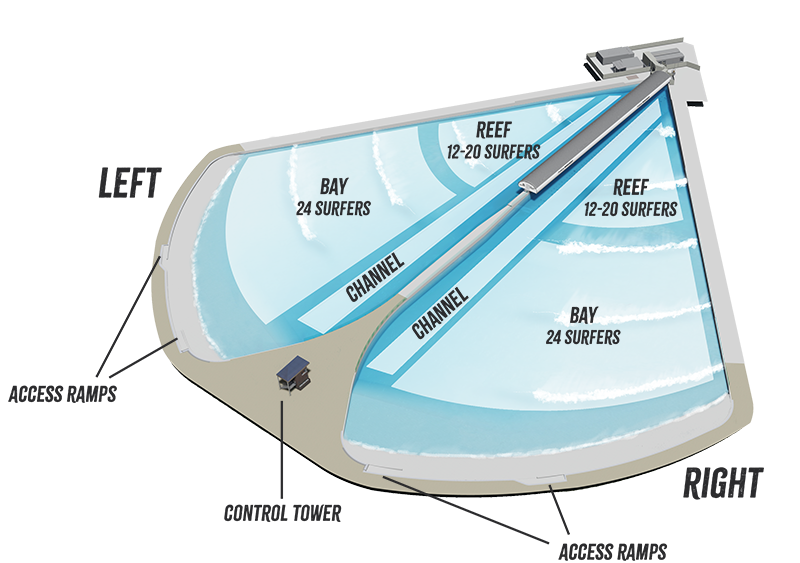Surf Terms
Before you arrive to Lost Shore, we understand that you might have questions around surfing and our Cove, that is why we have developed this section, providing basic key information!
Our Cove has different areas and elements that you should know about. It is separated by a central spine in two halves, the left and the right, where the engine room is located. In each side, you will find two surfing areas: the bay, with whitewater waves for beginners and the reef, with green waves designed for more advanced surfers.
Although waves will be breaking in the Cove, there will always be an area where this does not happen, called the channel, that runs along both sides of the central spine.
There is a kerb around the pool to make sure water does not splash out, but each side has two access ramps to access the water. To oversee operations and control the wave generating modules, we also have a control tower in the beachfront, overlooking the Cove.

Access ramps
Every surfer will get in and out of the Cove from the bays, using dedicated access ramps. These ramps are 1.5m wide and have been specifically designed for surfers of all abilities and needs. There will be two access ramps per side of the bay, one for getting in and other for exiting the Cove.
The bay
The bay is the closest area to the shore of the Cove and like at a standard beach, it is the shallowest part of the Cove, with a depth up to 1.2 metres. The waves generated in the reef break and enter the bay as whitewater, providing the perfect learning ground for beginner surfers.
The reef
The reef is the furthest area from the shore of the Cove, where the waves are generated. The reef is the area where improver, advanced and expert surfers can catch a variety of different unbroken waves based on their ability, and surf them along the open-face of the wave.
The channel
The channel is a strip of deep water that runs parallel to the central spine of the Cove on both sides. It is the deepest area of the Cove, with a depth of up to 2.5 metres. It is designed to create a rip current that flows from the bay to the reef, helping to dissipate the energy from the waves and enable surfers surfing the reef to paddle back into position.
Surfing on the right
The Cove has two sides, separated by the central spine and on each half, there is both a reef and a bay. The waves in the reef break from the side walls towards the central spine, with an open-face for surfing. While standing on the shore and looking out, the right half of the Cove produces right-hand waves, meaning that the surfer will surf them moving from the left to the right.
Surfing on the left
The Cove has two sides, separated by the central spine and on each half, there is both a reef and a bay. The waves in the reef break from the side walls and move towards the central spine, with an open-face for surfing. While standing on the shore and looking out, the left half of the Cove produces left-hand waves, meaning that the surfer will surf them moving from the right to the left.
Whitewater
The whitewater is the mass of white foam that is formed when a wave breaks. In the Cove, the whitewater rolls into the bay creating a perfect learning environment for beginner surfers.
Greenwave / unbroken wave
A greenwater wave is a wave that has not broken with an open-face to surf along. In the Cove, a variety of green water waves are available on the reef for intermediate, advanced and expert surfers.
Takeoff / pop up
The take off is the act of catching a wave on a surfboard. The pop up is the act of getting up onto your feet on a surfboard.
Wipeout
A wipe out is when a surfer comes off their surfboard and essentially ends their ride. It involves falling correctly, protecting your head and recovering your surfboard as soon as possible.
Barrel / tube
A barrel is the stage in a hollow and powerful wave where the lip of the wave projects forward over the water, creating a tubular space where the surfer can be completely surrounded by water. Surfing a barrel is one of the most difficult manoeuvres in the sport.
